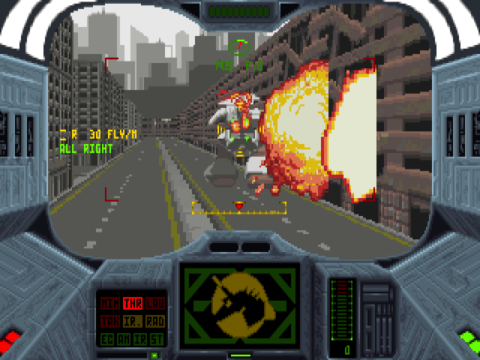
Iron Assault
Written by: Rik
Date posted: November 22, 2020
- Genre: Simulation
- Developed by: Graffiti
- Published by: Virgin Interactive Entertainment
- Year released: 1995
- Our score: 3
Like flight and space sims, big walking robots were a reasonably big deal in the 90s, with their prominence and technical prowess attracting generally positive press coverage and drawing the attention of PC gamers who were perhaps ill-equipped to contend with their complexities. Which is another way of saying that, while we both owned a copy of Mechwarrior 2, my friend and colleague made steady progress through the campaign, while I blew myself up during the training mission. (At least, that is how I’ve chosen to remember it: I have no idea whether this is actually possible or just a false memory that has crystallised my general incompetence in a single, more striking, image).
Iron Assault is little more than a footnote compared to the decade’s big hitters – the aforementioned Mechwarrior and Dynamix’s Earthsiege. It’s a curious affair that looked dated at the time of release, upon which it garnered largely indifferent reviews. And as such, it was a prime candidate for bargain bin territory, waiting to be snapped up by the less-discerning punter, low on cash and patience. Hence, your correspondent did of course buy this game, realising the error of his ways roughly 30 minutes after installation. My impressions at the time were: jeez, this looks awful, it feels nothing like you’re in a big robot, and the combat is kind of boring.
Despite the unreconstructed nature of these observations, based on a very limited sample size, a more significant investment of time has nevertheless proved them more or less accurate, with only the irrational desire to revisit and evaluate abandoned games from childhood and flesh out such sentiments in writing acting as an incentive to continue. I also held onto the notion that developers Graffiti (later Milestone), who had produced the scrappy but entertaining Screamer titles, must surely have been capable of knocking together a half-decent robot shooter. (As it turns out, this was pretty much their sole contribution to gaming history that wasn’t a racing game of some kind, which suggests they found what they were good at and stuck to it.)
In the time-honoured tradition, we find ourselves in a future in which the differences between corrupt global corporations and a plucky band of rebels must ultimately be resolved through battles between squadrons of giant robots. However, in Iron Assault‘s world, the robots don’t seem too giant, as they’re represented by rather puny stop-motion models in the introductory video cut-scenes, and by flat sprites in the game world. I don’t mean to be too unkind about the video sequences, but I do recall them being fairly prominent in the pre-release fluff, only to find these supposedly huge robots vaguely resembling ED-209. Maybe it’s the style for things to look very much like a child’s toy, but it does seem like an altogether odd choice for a game, in which there are a number of possibilities for creating large battle machines without having to resort to compromises that might be necessary for a low-budget film. In fact, the inclusion of video at all seems like an odd quirk, given that all of the cut-scenes are transitions and there is no dialogue or other interactions that make use of it.
Inside your base, you have the option of looking at your mission history or accessing WNET for any news from the campaign and details of the next mission, which includes vehicle and weapon selection. Early choices involve the fast and light machines, with more advanced hardware becoming available as you progress. Amusingly, one of the initial choices is called a Doggy, which is part of a recurring theme of animal-based machinery, with the Frog, the Ant and the Lobster all appearing in your opponent’s ranks. It certainly doesn’t help cultivate any sense of danger or intimidation, and neither do the flat graphics or the enemies’ rather camp ‘running away’ animation, triggered by sustaining significant damage.
In general, the sense of scale is lacking, even in the city-based levels, where clues as to your size are provided by smaller bits of scenery such as lampposts (which can be crushed underfoot), and with early missions limited to ‘kill all enemies’ it’s tempting to see Iron Assault as quite a basic FPS, and play it as such, making use of the strafe command and firing off the plentiful supplies of light missiles at will. You’re also exposed to the gung-ho posturing of our unnamed hero, who repeats numerous odious utterances, from the dreadful (but frequently repeated) ‘Pucker up, and kiss your butt goodbye!’ to the frankly tasteless ‘No-one’s climbing out of that mess alive!’ All good stuff, then, and delivered by an actor who’s aiming for Han Solo but delivers a mixture of Inspector Gadget and Wayne Campbell from Wayne’s World.
Despite appearances, though, this is indeed a mech game, and there are lots of settings and controls to play with. The HUD by default has a larger view of the terrain and (generally) a single monitor which allows you to cycle between radar, mini-map, damage report, countermeasures etc. The idea is that you can compromise the larger view by switching to the lower cockpit, which has a smaller window for the game world, but with more monitor options available at once. In reality, though, the size of the view in the latter is simply too small to make it worth your while, and when it comes to systems management, multiple monitors are rarely needed, so even if the single monitor option can be a bit fiddly at times, I personally found it preferable. Outdoors, the radar is the main useful option: the map can be accessed at any time using another key, the counter measures and auxiliary systems don’t need too much toggling, and you get a pretty good idea of damage from the main display.
Yes, I did say ‘outdoors’, because, unusually, lots of the action in Iron Assault actually takes place indoors, with the skirmishes outside increasingly becoming minor events compared to the main action inside bunkers, bases and warehouses. It seems like a bizarre choice, although perhaps it’s to distract the player from the small available selection of outdoor scenery, which is limited to the city, the desert, the snow and the sea (in the form of oil rigs). Does anyone seeking big robot action want to be confined to corridors and mazes? That’s the setting for the majority of action on offer here, and does indeed make it feel less of a big robot game and more like a forgettable 90s shooter.
These indoor bits are very dull indeed. The levels are very cramped and seem ill-suited to the lumbering nature of the combat (not to mention the general ridiculousness of having big robots launching multiple missiles at each other inside a structure without any danger of that structure being compromised in any way). In general, you’re not there to get in fights anyway (there are mentions of avoiding detection in the manual and a stealth setting on some machines, though I can’t imagine how this could be a viable strategy) but to pursue one of a variety of other destroy and/or pickup objectives: blow up a computer/power generator, rescue a pilot/scientist, etc.
The indoor art is very repetitive, and it’s easy to get lost. (For the love of God, remember to take a note of your location on the compass as you enter, otherwise you’ll spend even more time wandering identical corridors than you ever wanted, as there’s no map access in these sections). And because missions are largely indistinct from each other, with text briefings that repeat similar objectives, you can forget whether you’re supposed to destroy something or pick it up, and can sometimes end up doing the wrong thing. Graphics are used and reused, and there are red herring items that look the same as ones that were important on a previous level. There’s no indication that something is part of a key mission objective, and although there’s an option on the monitor to track your progress in terms of those objectives, there’s no way to access the briefing in full.
And so, Iron Assault soon becomes a largely joyless tramp through repetitive missions that come one after another with little or no context. The action is dated for its time, but could have been made more palatable with some supporting story or world building. You are kept up to date, to an extent, through the WNET news feature, but it’s bare minimum stuff, telling you the success in your last mission is very important to the campaign, or something similar. At the end of missions you’re told that secondary objectives should be completed (if you haven’t done them) but not why, although as it turns out they do have an impact in terms of unlocking extra weapons and other technology. New mechs and weapons do sort of register when you first use them, but it’s all presented in a very low-key way, with any sense of achievement minimised.
Progression also comes in the form of being promoted and being given access to the command of AI team mates. However, giving them specific commands or making any kind of tactical plan seems to be largely a waste of time, and hoping they follow you and help out a bit during combat seems to be the best you can hope for. Unfortunately, your buddies don’t seem able to follow you indoors, which rather reduces their importance somewhat. Special mention though must go to the pilot who quotes ex-England football manager Graham Taylor (‘Do I not like that!’) when under heavy fire.
Even further into the game, you direct a campaign, of sorts, by selecting missions on a map and prioritising targets with strategic importance. It made sense to me to hit the power stations and factories that supplied the bases first, and this did seem to impact the reported number of enemies protecting these bases on the map, although this wasn’t actually acknowledged in the mission briefings themselves which still reported heavy defences in place.
It doesn’t add a great deal to the action, to be honest. Missions still bleed into one another, with briefing after briefing about some strategic barrels that need to be picked up or destroyed, and the only change of pace being the occasional emergency missions when you’re called out of base to deal with something unexpectedly. It’s not too long before the mind starts to wander towards consideration of just how much longer it’s all going to drag on for: the war is a global one, and there’s some shifting about between the US and Europe early on, and my thought was that once you start to dictate strategy you’d have to win in both those continents to end the game. Sadly, this isn’t the case: kudos to the developers for recognising that Africa, Australasia and Asia are all part of the world too, but faced with even more of the same, it was at this point that I started to tire, and I persevered only until the point at which things got too hard.
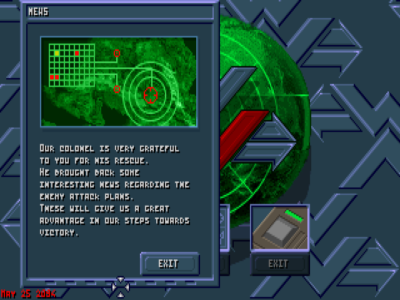
The Colonel is very grateful for his rescue, and has brought interesting news which will give us a great advantage.
Unfortunately this means I can’t confirm exactly what happens at the very end, and while I’m prepared to accept the possibility that the last 20% or so of the game is full of exciting surprises, I’m also going to stick my neck out and say that it’s extremely unlikely. (If you know otherwise, do write in: you could win a prize). Anyway, it suddenly became very difficult, mainly through overwhelming numbers of enemies, and I was left wondering whether I should have been learning how to employ more advanced combat techniques – aiming the turret and crosshairs while moving in a different direction, for example – that had hitherto been largely unnecessary. But it was too late by then.
As I said at the start, Iron Assault is a curious beast, particularly so for a PC-only release. I could sort of imagine it on a console, operating with simplified, joypad-only controls. But as it is, it kind of feels like it should be a contemporary of the first couple of Wing Commander games, rather than the third and fourth ones. It’s not utterly hateful, but it’s pretty dull and repetitive, and not particularly worth seeking out unless you have your own reasons for doing so.

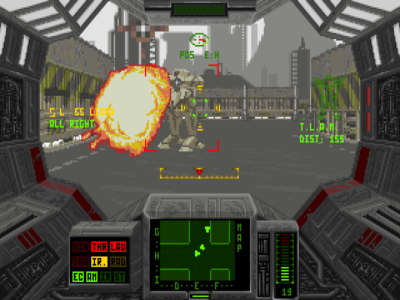
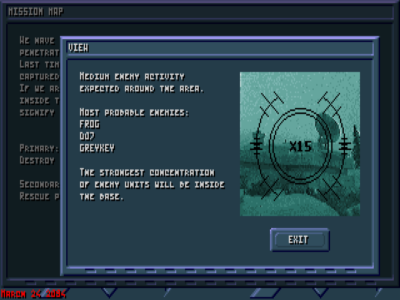
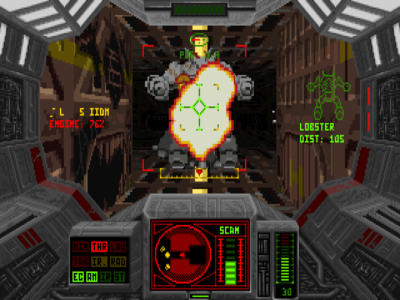
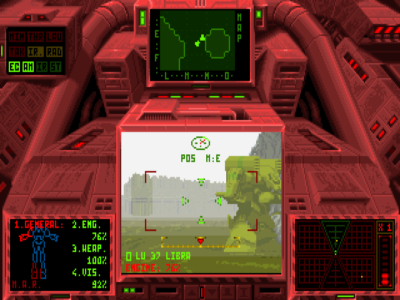

 Posts
Posts
Just a quick comment. Has a tag been made for articles that mention winning a prize? So far, I haven’t been able to qualify. Maybe one day? 😛
June 18, 2023 @ 5:46 am
No, and I’m sure I’d be embarrassed at the number of times I’ve used this same joke over the years. Although after a while the embarrassment becomes part of the fun…
Ironically I do now actually have some (low value) prizes that I could give away to a lucky winner!
[Edit: No prize is worth battling through to the end of Iron Assault for, however]
June 19, 2023 @ 4:54 pm